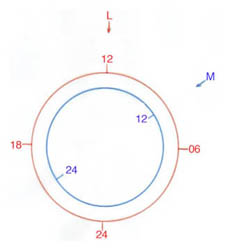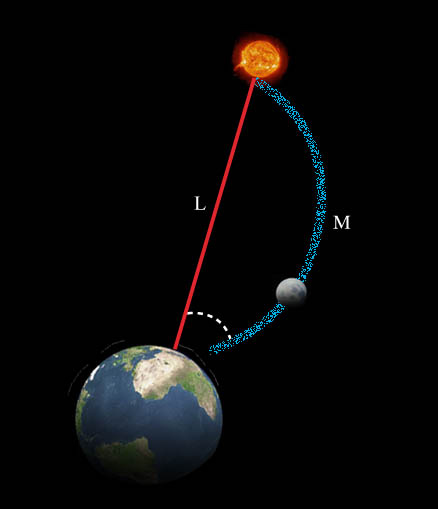The common meridian is given by the direction of the light coming from the Sun (L, red), the original reference, once adjusted, for the mean times of our clocks.
The seeds, the phenomenon of the “water figures”, and the tides, seem to follow natural clocks of their own, of magnetic nature, determined by the “magnetic meridian”, usually rather stable because protected by the magnetosphere, apart some occasional exception (M, blue).

The two beams.

The beam of light, which forms the common meridian, takes a little longer than eight minutes to arrive on the Earth, on a line, that in practice can be considered straight.
The beam of matter which forms the solar wind takes usually 92 to 118 hours to arrive close to the Earth.
Save extremely rare exceptions, as in the event Carrington, the minimum and maximum are of the order of 34 and 148 hours. As a first approximation, the longer it takes, the more it bends, when it crosses the Earth.
Angle variation.
The angle between the light beam and the matter beam would vary, depending on the solar wind features, above all on its speed.
So, as the solar wind velocity increases, the angle between the two beams would tend to get narrower. On the contrary, as the solar wind velocity descreases, that angle would tend to get wider.
The two beams with regard to the Earth.
While the magnetosphere is not an obstacle for the light beam, it proves to be an effective kind of protection vis à vis the impact of the solar wind. Though not always.
Breaches in the envelope.
At given circumstances, a breach of the magnetosphere may occur.
The magnetic meridian could be affected then by the solar wind, even at the mid magnetic latitudes, such as those of the Adriatic sea. Though on rare occasion, and for a limited duration. These exceptions could be more frequent in basins near the magnetic poles.
This would contribute, among other things, to a change in the timing of all the phenomena treated in this site.